5G: Network Agility Comes of Age
 Self-driving automobiles require that network delay or latency be reduced to less than a millisecond. Streaming 3D video and new immersive applications require massive bandwidth. Multi-millions of
IoT devices will require spectrum beyond what is currently accessible. Dramatic increases in data use at events and public venues will exacerbate already existing swings in capacity demand. A
proliferation of devices will intensify the need for densification of base stations — the ability to deliver more and more capacity within the same space.
Self-driving automobiles require that network delay or latency be reduced to less than a millisecond. Streaming 3D video and new immersive applications require massive bandwidth. Multi-millions of
IoT devices will require spectrum beyond what is currently accessible. Dramatic increases in data use at events and public venues will exacerbate already existing swings in capacity demand. A
proliferation of devices will intensify the need for densification of base stations — the ability to deliver more and more capacity within the same space.The demands placed on mobile networks by the 5G air interface will be complex, varied and strenuous. While current networks effectively support today’s requirements, delivering on the dramatic increase in demand, density and diversity of network requirements associated with 5G will require a very different approach, as today’s networks are simply inadequate. The limitations of fixed point-to-point architecture, of a dependence on traditional dedicated hardware, and of legacy technology have saddled operators with networks that cannot flex, adapt or scale to meet future needs. Current networks, by design, are rigid and rather limited.
Creating Agile Networks Through Virtualization
The approach of 5G is driving a shift toward a new kind of network architecture, an agile architecture that can enable key innovations, such as network slicing, wherein a single virtual network can be architected to function as multiple networks — each with its own specifications, for its own use case. To accommodate the complex and high performance requirements of 5G services, network operators need to find a way to bypass the limitations inherent in existing networks. To that end, new network architectures are combining network virtualization with an end-to-end perspective.Virtualization is the process of creating a "virtual" rather than "actual" version of the network. This is done by moving network functions that traditionally reside within dedicated hardware to a ‘virtualized’ or software-based environment to produce a virtual version of the network components. Once defined in software, the network components can be easily pooled, shared and accessed simply via interfaces. Virtualizing the network also opens the door for network fine-tuning and adaptations that are simply not possible with a traditional network such as demand dynamic allocation and the partitioning of resources among different users.
Virtualizing the Base Stations
Base station resources, once virtualized, can be centralized and their capacity allocated dynamically according to network load. This increased efficiency potentially lowers the overall base station requirement of the network resulting in a smaller footprint and in turn, reduced operating expenditures from lower rental and electricity costs. As virtualized base stations can use generic commodity hardware instead of dedicated equipment, capital equipment costs can also be reduced.





















